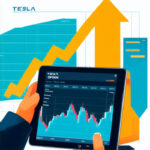What Do Tesla Stock Predictions Say About 2025? Key Insights Revealed

Introduction to Tesla Stock Predictions 2025
As we approach the mid-2020s, the buzz around Tesla’s stock performance continues to captivate investors and market analysts alike. Speculating about “Tesla stock predictions 2025” has become a focal point for many stakeholders aiming to understand where this electric vehicle (EV) giant is heading. In this blog post, we will delve into various aspects that could shape Tesla’s stock in 2025, offering key insights from experts, financial metrics to watch, and potential risks and opportunities. By the end, you’ll have a well-rounded view of what to expect from Tesla stock in 2025.
Overview of Tesla’s Market Position
Since its inception, Tesla has positioned itself as a trailblazer in the electric vehicle industry. With a market capitalization exceeding several traditional auto manufacturers, Tesla’s influence extends beyond automobiles to energy solutions and beyond. The company’s strong brand recognition and innovative approach have solidified its market position, making it a leader in both market share and technological advancements. This dominant position is crucial when considering “Tesla stock predictions 2025” as it underscores the company’s ability to leverage its strengths for future growth.
Importance of Stock Predictions
Stock predictions are vital for investors aiming to make informed decisions. They help in understanding potential future performance and guiding investment strategies. When it comes to Tesla, these predictions are particularly significant due to the company’s volatile nature and its pioneering role in the rapidly evolving EV market. Accurate forecasts can provide insights into the company’s trajectory, offering a glimpse of what to expect in terms of stock value and overall market performance by 2025.
Brief Look at Historical Performance
To understand the potential future of Tesla’s stock, it’s essential to look at its historical performance. Over the past decade, Tesla’s stock has seen remarkable growth, punctuated by periods of significant volatility. The company has consistently exceeded market expectations, driven by robust sales, innovative products, and strategic market expansions. This historical context provides a foundation for predicting future trends, emphasizing the importance of considering past performance when making “Tesla stock predictions 2025.”
Factors Influencing Tesla Stock Predictions 2025
Technological Innovations
Technological advancements will play a pivotal role in shaping Tesla’s stock predictions for 2025. The company’s ongoing innovations in battery technology, autonomous driving, and AI integration are expected to drive growth. Breakthroughs in these areas could lead to improved vehicle performance, reduced production costs, and enhanced consumer appeal, all of which are critical factors in predicting future stock performance. Investors should keep a close eye on Tesla’s R&D efforts and their potential market implications in the coming years.
Market Demand for Electric Vehicles
The global demand for electric vehicles is another significant factor influencing Tesla’s stock predictions for 2025. As more consumers and businesses shift towards sustainable transportation, the demand for EVs is expected to rise. Tesla, being a market leader, stands to benefit immensely from this trend. Factors such as consumer preferences, advancements in charging infrastructure, and the overall shift towards green energy will play crucial roles in determining the market demand for Tesla’s products and, consequently, its stock performance.
Government Regulations and Incentives
Government policies and incentives are also critical in shaping “Tesla stock predictions 2025.” Many countries are implementing stricter emission regulations and offering incentives for electric vehicle purchases to combat climate change. These policies can significantly boost Tesla’s sales and market presence. However, any changes in regulations or incentives could impact the company’s performance. Investors should monitor global regulatory trends and their potential effects on Tesla’s operations and stock value.
Expert Opinions on Tesla Stock Predictions 2025
Analysts’ Forecasts
Financial analysts from various institutions have provided differing forecasts for Tesla’s stock by 2025. While some predict continued growth driven by innovative products and market expansion, others caution about potential overvaluation and market saturation. Analysts’ insights are based on comprehensive financial models and market analysis, offering valuable perspectives for investors. It’s important to consider these forecasts while also recognizing the inherent uncertainties in stock predictions.
Financial Institutions’ Projections
Major financial institutions have also weighed in on Tesla’s future stock performance. Banks and investment firms often provide detailed projections based on economic indicators, market trends, and company-specific factors. These projections can range from optimistic to conservative, reflecting differing views on Tesla’s growth potential and market challenges. Investors can use these projections to gain a broader understanding of potential scenarios and make more informed investment decisions.
Influential Investors’ Views
Opinions from influential investors and market leaders can also impact “Tesla stock predictions 2025.” Figures such as Elon Musk and renowned market analysts often share their views on Tesla’s future, which can influence public perception and investor sentiment. These insights, combined with broader market analysis, can provide a well-rounded view of Tesla’s potential trajectory. However, it’s essential to critically evaluate these opinions and consider them within the broader context of financial analysis.
Financial Metrics to Watch for Tesla in 2025
Revenue Growth Projections
Revenue growth is a key metric to watch when considering Tesla’s future stock performance. Analysts predict that Tesla’s revenue will continue to grow, driven by increased vehicle sales, expansion into new markets, and diversification into energy solutions. Monitoring revenue growth trends can provide insights into the company’s market performance and potential stock value. Investors should pay attention to quarterly and annual revenue reports to gauge Tesla’s financial health and growth trajectory.
Profit Margins and Earnings Per Share (EPS)
Profit margins and earnings per share (EPS) are crucial indicators of a company’s profitability and financial performance. For Tesla, improving profit margins and consistent EPS growth are positive signs for investors. These metrics reflect the company’s ability to manage costs, increase efficiency, and generate profits. By analyzing profit margins and EPS trends, investors can assess Tesla’s financial stability and potential for future growth, providing a clearer picture of its stock value in 2025.
Key Financial Ratios
Several financial ratios are essential for understanding Tesla’s financial performance and stock potential. Ratios such as the price-to-earnings (P/E) ratio, return on equity (ROE), and debt-to-equity ratio provide insights into the company’s valuation, profitability, and financial leverage. These ratios help investors evaluate Tesla’s financial health and compare it with industry peers. Monitoring these key financial ratios can aid in making informed investment decisions and predicting Tesla’s stock performance in 2025.
Potential Risks and Challenges for Tesla in 2025
Competition in the EV Market
As the electric vehicle market grows, so does the competition. Tesla faces increasing competition from established automakers and new entrants in the EV space. Companies like Ford, General Motors, and new startups are launching competitive electric models, challenging Tesla’s market share. This heightened competition could impact Tesla’s sales, profit margins, and market position. Investors should consider the competitive landscape and potential challenges when making “Tesla stock predictions 2025.”
Supply Chain Issues
Supply chain disruptions pose another significant risk for Tesla. The global semiconductor shortage and other supply chain challenges have already impacted automotive production. Any prolonged or new supply chain issues could hinder Tesla’s ability to meet production targets and fulfill customer demand. These disruptions can lead to increased costs, delays, and reduced profitability. Investors should monitor supply chain developments and their potential impact on Tesla’s operations and stock performance.
Economic and Geopolitical Factors
Economic and geopolitical factors can also influence Tesla’s stock performance. Global economic conditions, trade policies, and geopolitical tensions can affect consumer demand, production costs, and market access. For example, trade tariffs or political instability in key markets could impact Tesla’s sales and profitability. Investors should consider these broader economic and geopolitical factors when evaluating Tesla’s stock predictions for 2025 and beyond.
Opportunities for Tesla’s Growth in 2025
Expansion into New Markets
Expanding into new markets presents significant growth opportunities for Tesla. The company is continually exploring new regions and countries to introduce its electric vehicles and energy solutions. Market expansions, particularly in emerging economies with growing demand for sustainable transportation, can drive revenue growth and increase market share. Investors should watch for Tesla’s announcements and plans for entering new markets, as these expansions can positively impact the company’s stock performance.
Innovations in Battery Technology
Advancements in battery technology are crucial for Tesla’s future growth. The company is investing heavily in developing next-generation batteries that offer higher energy density, longer range, and faster charging times. Breakthroughs in battery technology can enhance vehicle performance, reduce costs, and improve consumer adoption rates. These innovations can provide Tesla with a competitive edge and drive future growth. Investors should stay informed about Tesla’s battery technology developments and their potential market implications.
Autonomous Driving and AI Integration
Autonomous driving and AI integration represent significant growth opportunities for Tesla. The company’s advancements in self-driving technology and artificial intelligence can revolutionize transportation and create new revenue streams. Tesla’s Full Self-Driving (FSD) system and AI capabilities are expected to play a crucial role in the future of mobility. Successful implementation and commercialization of these technologies can enhance Tesla’s market position and drive stock value. Investors should monitor progress in autonomous driving and AI integration for potential growth opportunities.
How to Interpret Tesla Stock Predictions 2025
Short-term vs. Long-term Predictions
When interpreting “Tesla stock predictions 2025,” it’s essential to distinguish between short-term and long-term predictions. Short-term predictions often focus on immediate market trends, quarterly earnings, and near-term challenges. In contrast, long-term predictions consider broader trends, technological advancements, and strategic growth opportunities. Investors should balance both perspectives to make informed decisions, recognizing that short-term volatility may not necessarily reflect long-term potential.
Impact of Market Volatility
Market volatility is an inherent aspect of stock investments, and Tesla is no exception. The company’s stock has experienced significant fluctuations driven by market sentiment, news events, and broader economic factors. Investors should be prepared for potential volatility when considering Tesla’s stock predictions for 2025. Understanding the factors contributing to market volatility and maintaining a long-term investment perspective can help navigate these fluctuations and make more informed decisions.
Strategies for Investors
Investors can adopt various strategies to navigate Tesla’s stock predictions for 2025. Diversifying investments, setting realistic expectations, and staying informed about market trends and company developments are essential strategies. Additionally, considering a mix of short-term and long-term investment goals can help balance risk and reward. Consulting with financial advisors and conducting thorough research can further enhance investment strategies and ensure informed decision-making.
Conclusion: What to Expect from Tesla Stock by 2025
Summary of Key Insights
In summary, “Tesla stock predictions 2025” encompass various factors, including technological innovations, market demand, government policies, and expert opinions. Financial metrics such as revenue growth, profit margins, and key ratios provide essential insights into Tesla’s financial health. Potential risks, such as competition, supply chain issues, and economic factors, should also be considered. Understanding these elements can help investors make informed predictions and investment decisions.
Final Thoughts on Investment Strategy
Investing in Tesla’s stock requires a balanced approach, considering both opportunities and risks. Staying informed about market trends, technological advancements, and regulatory changes is crucial. Investors should adopt a diversified investment strategy, balancing short-term and long-term goals. Consulting with financial advisors and continuously monitoring Tesla’s performance can enhance investment decisions. With careful analysis and informed strategies, investors can navigate the dynamic landscape of Tesla’s stock in 2025.
Future Outlook Beyond 2025
Looking beyond 2025, Tesla’s future appears promising, driven by continued innovation, market expansion, and advancements in sustainable transportation. The company’s vision for a sustainable future and its pioneering role in the EV market position it for long-term growth. While challenges and uncertainties remain, Tesla’s commitment to innovation and market leadership provides a strong foundation for future success. Investors should keep an eye on Tesla’s developments and evolving market trends to stay ahead of the curve and make informed investment decisions.

Laura Henderson is an enthusiast and has been writing on cutting-edge topics for years.







